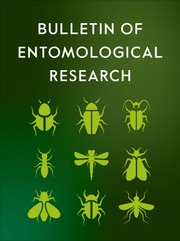Ver ítem
- xmlui.general.dspace_homeCentros Regionales y EEAsCentro Regional Patagonia NorteEEA Alto ValleArtículos científicosxmlui.ArtifactBrowser.ItemViewer.trail
- Inicio
- Centros Regionales y EEAs
- Centro Regional Patagonia Norte
- EEA Alto Valle
- Artículos científicos
- Ver ítem
Lethal effect of Goniozus legneri on Cactoblastis cactorum: A potential biocontrol agent for inundative releases
Resumen
Cactoblastis cactorum (Berg) (Lepidoptera: Pyralidae), the cactus moth, is native to South America with a widespread distribution in Argentina. The larvae consume the interior of Opuntia spp. (Cactaceae) plants. The moth was used as a biocontrol agent against invasive non-native Opuntia spp. in many countries around the world. The cactus moth arrived unintentionally in Florida, USA, expanded its range and threatened Opuntia-based agriculture and natural
[ver mas...]
Cactoblastis cactorum (Berg) (Lepidoptera: Pyralidae), the cactus moth, is native to South America with a widespread distribution in Argentina. The larvae consume the interior of Opuntia spp. (Cactaceae) plants. The moth was used as a biocontrol agent against invasive non-native Opuntia spp. in many countries around the world. The cactus moth arrived unintentionally in Florida, USA, expanded its range and threatened Opuntia-based agriculture and natural ecosystems in southern North America. The insect is also a pest of cultivated O. ficus-indica L. in Argentina. An endemic South American parasitoid, Goniozus legneri Gordth (Hymenoptera: Bethylidae), is used in inundative biological control programmes against lepidopteran pests. The goal of this work was to evaluate G. legneri as a biocontrol agent to be used in inundative releases against C. cactorum. Mortality of C. cactorum by G. legneri was assessed at different spatial scales, as well as the interactions with Apanteles opuntiarum Martínez & Berta (Hymenoptera: Braconidae), a common Argentine natural enemy of C. cactorum. The ability of G. legneri to paralyse, parasitise and kill C. cactorum was confirmed. The paralysis inflicted on C. cactorum larvae reduced larval damage to the plants by 85%. Using two parasitoid species increased the mortality of C. cactorum larvae, but it was highly dependent on the order of their arrival. The combined mortality caused by both parasitoids was higher than a single one, in particular when G. legneri arrived first (56 ± 1%), suggesting asymmetric competition due to the preference of G. legneri attacking previously parasitised larvae. Goniozus legneri has potential as an inundative biocontrol agent of C. cactorum, but its interaction with the classical biocontrol agent A. opuntiarum needs to be considered.
[Cerrar]

Autor
Varone, Laura;
Faltlhauser, Ana Claudia;
Fuentes Corona, Malena;
Garrido, Silvina Alejandra;
Cichon, Liliana;
Cecere, María Carla;
Hight, Stephen D.;
Bruzzone, Octavio Augusto;
Fuente
Bulletin of Entomological Research 114 (1) : 149-158 (February 2024)
Fecha
2024-01-25
Editorial
Cambridge University Press
ISSN
0007-4853 (Print)
475-2670 (Online)
475-2670 (Online)
Formato
pdf
Tipo de documento
artículo
Palabras Claves
Derechos de acceso
Restringido
 Excepto donde se diga explicitamente, este item se publica bajo la siguiente descripción: Creative Commons Attribution-NonCommercial-ShareAlike 2.5 Unported (CC BY-NC-SA 2.5)
Excepto donde se diga explicitamente, este item se publica bajo la siguiente descripción: Creative Commons Attribution-NonCommercial-ShareAlike 2.5 Unported (CC BY-NC-SA 2.5)


